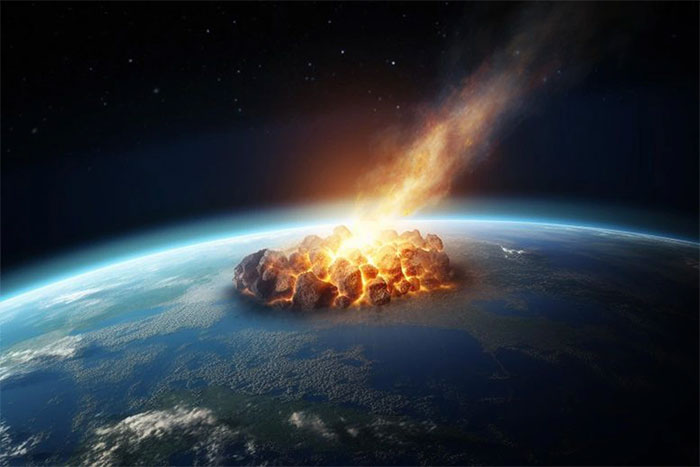A giant meteorite once crashed into Earth, 200 times larger than the meteorite that wiped out the dinosaurs.
The energy from the powerful impact completely vaporized the meteorite, causing tsunamis that swept away the seabed and submerged coastlines around the world.
66 million years ago, a giant meteorite crashed into Earth, ending the era of the dinosaurs and causing a global extinction.
However, according to new research published in the journal Proceedings of the National Academy of Sciences , this is not the largest impact ever to hit our planet.
The Destructive Collision of a Giant Meteorite

Illustration of a meteorite colliding with Earth - (Photo: SciTechDaily).
According to research, about 3.26 billion years ago, a meteorite 200 times larger than Earth hit the Earth , causing devastation on an even more terrible scale.
But surprisingly, this catastrophe may have played a key role in the early evolution of life , by providing essential nutrients for bacteria and ancient single-celled organisms.
Scientists from Harvard University (USA), led by geologist Nadja Drabon, discovered evidence of this collision through ancient rock layers at the Barberton Greenstone Belt - an area in northeastern South Africa.
Geochemical signatures and fossils of marine bacteria preserved in the rocks show that rather than being destroyed, life not only recovered but thrived after this terrible impact.
According to research, the meteorite that collided with Earth about 3.26 billion years ago was estimated to be 37-58km in diameter, much larger than the meteorite that caused the extinction of the dinosaurs. This type of meteorite, scientifically known as "carbonaceous chondrite ", contains a lot of carbon and phosphorus - important elements for life.
The energy from the powerful impact completely vaporized the meteorite along with the sediments and rocks it hit, creating a cloud of dust and rock vapor that covered the entire Earth, turning the sky black in just a few hours.
Not only that, the massive tsunami created by the impact swept away the seafloor and submerged coastlines around the world. The ocean surface temperature rose so high that the top layer of water began to boil, creating a terrifying scene of destruction.
"Fertilizer bomb" for primitive life

Traces of Earth's plate tectonics found in sediments dating back 3.2 billion years - (Photo: Visdia/Getty Images).
While the images of near-total devastation may seem terrifying, scientists believe the impact acted as a "giant fertilizer bomb" for primitive life.
After the dust settled and temperatures returned to normal, the meteorite delivered a large amount of phosphorus to Earth, a nutrient crucial for microbes. At the same time, the tsunami mixed iron-rich deep waters with shallow waters, creating the perfect environment for ancient bacteria and single-celled organisms to thrive.
"We often think of meteorite impacts as catastrophic events that destroy life, " said scientist Nadja Drabon . "However, in the context of 3.2 billion years ago, when life was very simple, these impacts may have created favorable conditions for the development of bacteria and single-celled organisms."
During the Paleoarchean period, the time of the impact, the Earth's surface was mostly ocean, with only a few volcanoes and raised continental plates. There was no oxygen in the atmosphere, and organisms with nucleated cells had not yet appeared. Life was dominated by bacteria and single-celled organisms, which were able to recover quickly and adapt to their environment after the disaster.
While the impact may have caused widespread devastation to sun-dwelling organisms and shallow-water organisms, research suggests that life recovered fairly quickly. Within a few years to decades of stabilizing the atmosphere and oceans, microbes were thriving again.
Geological evidence from the Barberton Greenstone Belt area — including chemical traces of the meteorite, tiny structures formed from molten rock and patches of sediment on the seafloor — has helped scientists better understand the impact and how life survived the disaster.
"Life on Earth at that time showed an incredible ability to withstand such huge impacts. This is a testament to the resilience and adaptability of life, even at its earliest stages," said Harvard University geologist Andrew Knoll, co-author of the study.
This new discovery not only helps us better understand the effects of meteorite impacts in Earth's history, but also sheds light on their role in driving the evolution of life.
From a scientific perspective, what seems like a catastrophic disaster may have been a powerful catalyst for the development and evolution of primitive organisms, contributing to the diversity of life as we know it today.
- Recreating the meteorite disaster 66 million years ago made the dinosaurs extinct
- NASA speaks about meteorites larger than the Great Pyramid rushing to Earth
- Huge meteorites make the Earth hot to 2,300 degrees Celsius
- Giant meteors are about to fly through the earth
- Suffering from meteorite disaster but why dinosaurs are extinct, birds are not?
- Dinosaurs are the most 'black' creatures on Earth's history
- A giant meteorite just flew over Earth
- Giant asteroids are about to fly over the Earth
- NASA says a giant meteorite will fly over the Earth in the next 48 hours
- How big a meteorite can wipe out life on Earth?
- A meteorite as big as the Great Pyramid is about to fly over the Earth
- Contact between the extinction of dinosaurs and acid rain
 Van Allen's belt and evidence that the Apollo 11 mission to the Moon was myth
Van Allen's belt and evidence that the Apollo 11 mission to the Moon was myth The levels of civilization in the universe (Kardashev scale)
The levels of civilization in the universe (Kardashev scale) Today Mars, the sun and the Earth are aligned
Today Mars, the sun and the Earth are aligned The Amazon owner announced a secret plan to build a space base for thousands of people
The Amazon owner announced a secret plan to build a space base for thousands of people